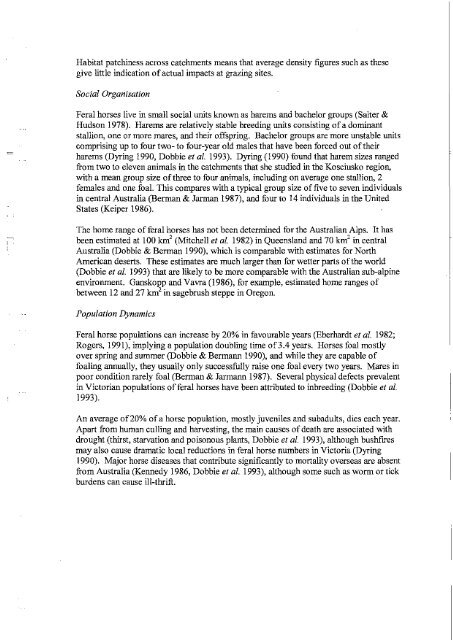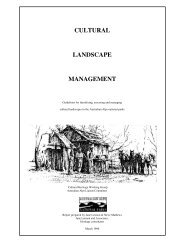Assessment of Impacts of Feral Horses - Australian Alps National ...
Assessment of Impacts of Feral Horses - Australian Alps National ...
Assessment of Impacts of Feral Horses - Australian Alps National ...
Create successful ePaper yourself
Turn your PDF publications into a flip-book with our unique Google optimized e-Paper software.
Habitat patchiness across catchments means that average density figures such as these<br />
give little indication <strong>of</strong> actual impacts at grazing sites.<br />
Social Organisation<br />
) i<br />
r<br />
<strong>Feral</strong> horses live in small social units known as harems and bachelor groups (Salter &<br />
Hudson 1978). Harems are relatively stable breeding units consisting <strong>of</strong> a dominant<br />
stallion, one or more mares, and their <strong>of</strong>fspring. Bachelor groups are more unstable units<br />
comprising up to four two- to four-year old males that have been forced out <strong>of</strong> their<br />
harems (Dyring 1990, Dobbie et al. 1993). Dyring (1990) found that harem sizes ranged<br />
from two to eleven animals in the catchments that she studied in the Kosciusko region,<br />
with a mean group size <strong>of</strong> three to four animals, including on average one stallion, 2<br />
females and one foal. This compares with a typical group size <strong>of</strong> five to seven individuals<br />
in central Australia (Berman & Jarman 1987), and four to 14 individuals in the United<br />
States (Keiper 1986).<br />
The home range <strong>of</strong> feral horses has not been determined for the <strong>Australian</strong> <strong>Alps</strong>. It has<br />
been estimated at 100 km 2 (Mitchell et al. 1982) in Queensland and 70 km 2 in central<br />
Australia (Dobbie & Berman 1990), which is comparable with estimates for North<br />
American deserts. These estimates are much larger than for wetter parts <strong>of</strong> the world<br />
(Dobbie et al. 1993) that are likely to be more comparable with the <strong>Australian</strong> SUb-alpine<br />
environment. Ganskopp and Vavra (1986), for example, estimated home ranges <strong>of</strong><br />
between 12 and 27 km 2 in sagebrush steppe in Oregon.<br />
Population Dynamics<br />
<strong>Feral</strong> horse populations can increase by 20% in favourable years (Eberhardt et al. 1982;<br />
Rogers, 1991), implying a population doubling time <strong>of</strong>3.4 years. <strong>Horses</strong> foal mostly<br />
over spring and summer (Dobbie & Bermann 1990), and while they are capable <strong>of</strong><br />
foaling annually, they usually only successfully raise one foal every two years. Mares in<br />
poor condition rarely foal (Berman & Jarmann 1987). Several physical defects prevalent<br />
in Victorian populations <strong>of</strong> feral horses have been attributed to inbreeding (Dobbie et al.<br />
1993).<br />
I<br />
I<br />
'<br />
An average <strong>of</strong>20% <strong>of</strong> a horse population, mostly juveniles and subadults, dies each year.<br />
Apart from human culling and harvesting, the main causes <strong>of</strong> death are associated with<br />
drought (thirst, starvation and poisonous plants, Dobbie et al. 1993), although bushfrres<br />
may also cause dramatic local reductions in feral horse numbers in Victoria (Dyring<br />
1990). Major horse diseases that contribute significantly to mortality overseas are absent<br />
from Australia (Kennedy 1986, Dobbie et al. 1993), although some such as worm or tick<br />
burdens can cause ill-thrift.
















